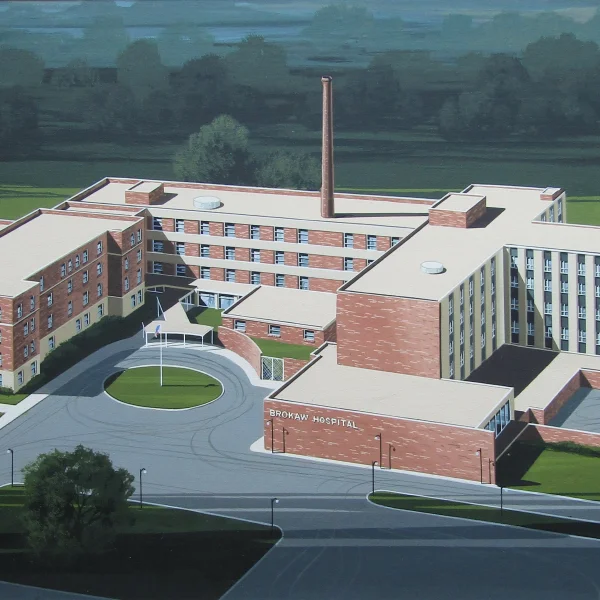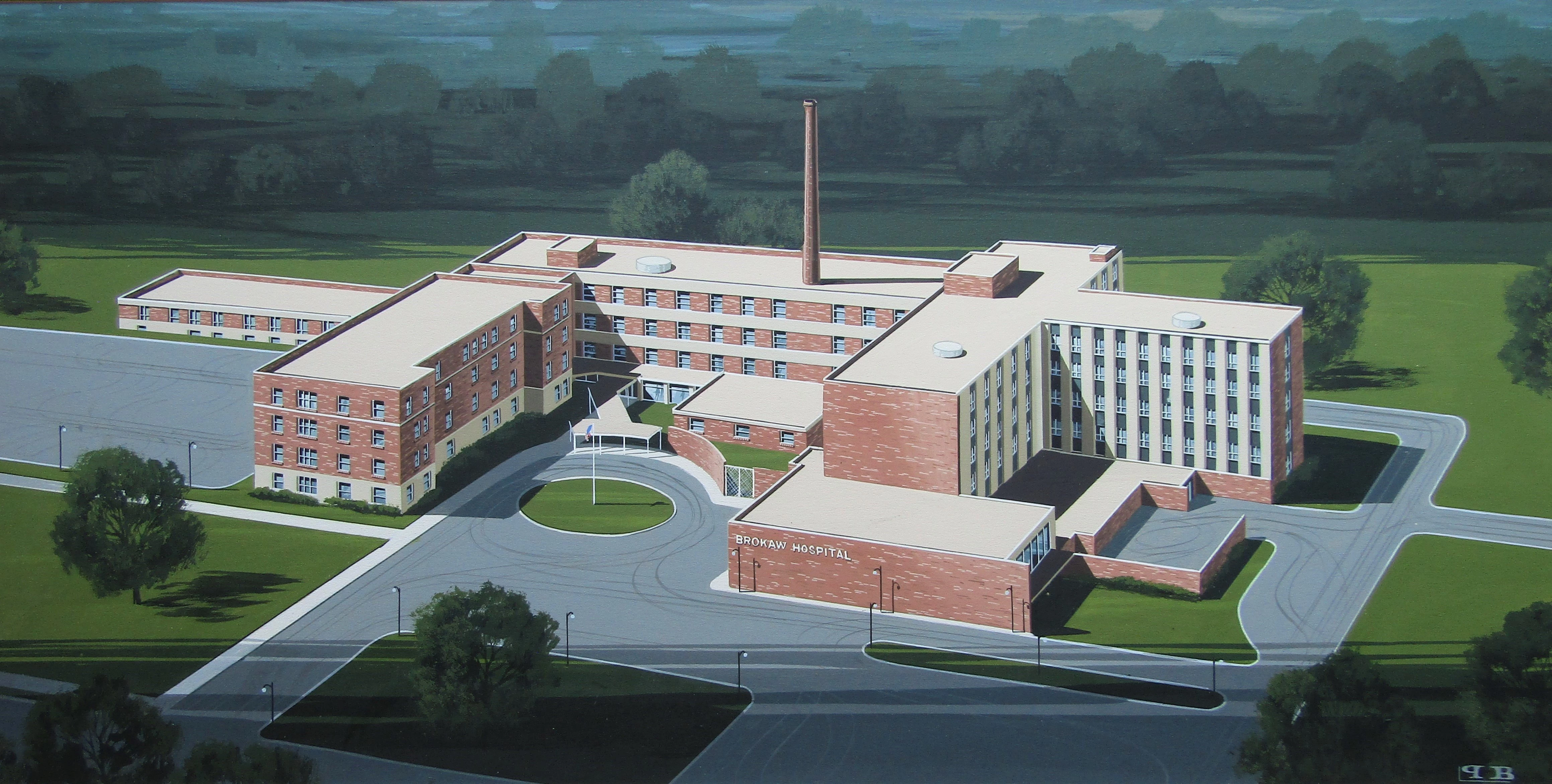Carle BroMenn Medical Center has undergone one transformation after another since its modest beginnings 125 years ago. It opened on May 8, 1896, as the 22-bed Deaconess Hospital—this nearly a quarter century before the discovery of antibiotics. Today, the medical center offers everything from cardiac electrophysiology to interventional radiology.
About the only thing that hasn’t changed is its central location—where Franklin and Virginia avenues meet in Normal.
Deaconess Hospital owes its origin to a group of local doctors who believed Bloomington-Normal was ready to support a second traditional hospital, specifically one not tied to the Catholic Church. St. Joseph’s Hospital, originally located on Bloomington’s west side, dates to 1880.
The “Protestant” hospital got its name from non-ordained women (often Methodists)—known as deaconesses—whose ministry work included serving as nurses.
It’s nigh impossible to overemphasize the profound transformations in hospital care since BroMenn’s founding years. According to its annual report of 1899, Deaconess Hospital cared for 178 patients and conducted 104 operations. “Liberal donations of bread, fruit, jellies, and flowers were received,” it was noted. “The ladies aid societies met each week to sew for the hospital. They furnished their own materials from the money received through dues of 10 cents a month.”
In 1901, Deaconess Hospital changed its name to Brokaw, as tribute to its main benefactor Abram Brokaw, a Bloomington plow maker who made a small fortune investing in farmland.
Brokaw is the “Bro” in BroMenn. The “Menn” comes from Mennonite Hospital, established in 1919-20 and occupying an old homeopathic sanitarium on the north end of downtown Bloomington. German Mennonites settled in Central Illinois in large numbers, and operating a hospital dovetailed with the Mennonite tradition of pastoral care and community service. The nursing school associated with this hospital thrives today as Illinois State University’s Mennonite School of Nursing.
In 1984, Brokaw Hospital merged with Mennonite to create BroMenn Healthcare. The former Mennonite Hospital became a center for allied health services, such as long-term senior care. BroMenn finally vacated the old hospital in 1998, and since then most of the complex has fallen to the wrecking ball, replaced with vacant, weedy lots awaiting redevelopment.
Twelve years ago, in 2009, BroMenn became part of Oak Brook-based Advocate Health Care. And then last summer, Carle Health of Urbana purchased BroMenn and Eureka hospitals for $190 million.
Whew! From Deaconess Hospital to Carle BroMenn Medical Center—that’s a lot of history in 125 years. Fortunately, with the help of the McLean County Museum of History, the story of these hospitals is being saved for generations to come.
In February of this year, Carle BroMenn administrators invited museum staff to the medical center complex to examine the combined archives of Brokaw, Mennonite, and BroMenn hospitals. After consultation and discussion, both parties agreed the museum was best equipped to ensure the safekeeping, preservation and cataloging of these materials.
During a series of return trips in March, Museum staff methodically sorted through the piles of scrapbooks, annual reports, employee newsletters, fundraising appeals, photographs, blueprints, framed architectural renderings, nursing school yearbooks, and so on. This initial “shakedown” left 36 banker boxes worth of history. A more rigorous weeding of duplicate materials, as well as the painstaking item-by-item inventory of each subset of this collection, would wait until later.
On May 19, the boxes were trucked to the museum. “We’re absolutely thrilled that [BroMenn’s] archives will now be in the great care of the McLean County Museum of History,” Tim Bassett, Carle BroMenn Vice President, Operations, said at the time.
Of course, having all this historically invaluable material is great, but if students, genealogists, local residents, researchers and others aren’t aware of these donated collections, or don’t know how to access them, then what’s the point of collecting all this “stuff” in the first place? That’s why the McLean County Museum of History takes seriously its mission to not only preserve the past, but to make that history available to the public at large—today and tomorrow.
As a not-for-profit institution, the museum relies to a considerable extent on volunteers and college interns to help organize and inventory these collections. This summer, the museum welcomed ISU graduate history major Dennis Baffour Awuah, who is currently organizing singular parts of the larger BroMenn collection. The museum was lucky to have an intern of Dennis’ qualifications and abilities, as he already has an impressive body of academic scholarship relating to healthcare and his home nation of Ghana.
For his summer internship, Awuah first pulled together all the scattered and disparate material relating to Brokaw Hospital and nursing—including correspondence from student nurses—and then organized it all into the Brokaw Hospital Nursing Collection.
Awuah's current project involves the Ruth Carpenter papers, two boxes of which were found among the BroMenn archives. Carpenter, who passed away in 2000 at the age of 90, was a 1931 graduate of the Brokaw Hospital Training School. She worked as a private duty nurse, as well as in several doctors’ offices and the Fairview Tuberculosis Sanatorium. The Carpenter collection includes her schoolwork and letters, among other treasures.
With both the Brokaw Hospital Nursing and the Ruth Carpenter collections, Awuah is creating a detailed, nearly item-by-item inventory known as a finding aid. The museum will then post these finding aids on its website—www.mchistory.org—where they show up on Google and other Internet search engines. Currently, the museum has 468 such collection finding aids on its website—ranging from the Alton Railroad Community Band Collection to the Charles J. Zobrist WW I Collection.
That’s not to say the collections themselves are digitized and available online for viewing and downloading (although that day will come, it’s still a way’s off.) Even so, knowing what’s out there and where it’s at is crucial to keeping our shared past alive. From there, all it takes is a visit to the McLean County Museum of History, or a phone call or email to Museum Librarian Bill Kemp.
In the ensuing months, the museum will continue to organize and inventory parts of the Carle BroMenn donation, including those having to do with the earliest years of Brokaw and Mennonite hospitals. There are many forgotten stories yet to be remembered and retold.

